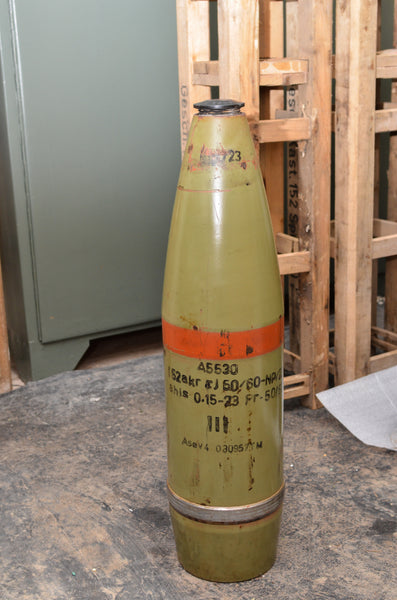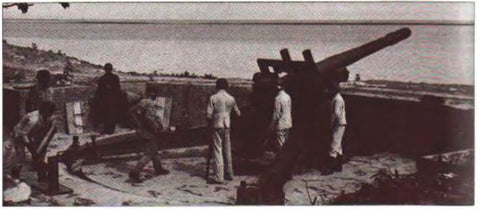German 152mm H.E. shell
Artillery across all belligerents of the second world war came in a wide spectrum of sizes. However, some calibers and their designated guns stand out more than others, as acclaimed by the gunners who fired them.
Today we're taking a closer look at a rare shell for a guns used by at least 3 armies during the war, and which remained in service for generations with countless other armies. Here's a closer look at the German-Made 152mm shell for the Russian M1937 and M1938 Field Howitzers.

Background history
Captured in significant quantities by the Germans at the beginning of Operation Barbarossa (invasion of the Soviet Union in 1941), Russian M1937 and M1938 howitzer guns were immediately included in the arsenal of the German Army, which gave them the new nomenclature 15,2 cm sFH 433(r) and sFH 443 (r) respectively. As had also happened with captured French field guns, the German Army (Heer) started producing shells to keep these guns in service once the captured munitions were depleted. Production of such munitions started on February 1943.
Captured 152mm guns were pressed by the German army in the Soviet Union and in Coastal defensive duties in southern France, Italy and along the Atlantic Wall.
Whilst these recently acquired examples by us are of German manufacture, they come from a batch which were sold to the the their allies, the Finns, during the Continuation War in first part of 1944 for use with their Russian captured howitzers . The M-10 and ML-20 (as were the nomenclatures by the Finnish Army) 152mm guns remained in their service until the turn of the century.
A Russian Howitzer used by the Germans as a Coastal Artillery gun.
Closer Look
To further explore the history of this shell, the example shown now carries post-war Finnish Army paint. However, upon closer examination, one can still observe the excellent state of preservation after 74 years, such as the original factory machine milling marks and other wartime stamps. Interesting markings were cross referenced with 7 other similar shells and include:
weight class (Gewichtsklasse) - These markings at the ogive of the shell indicates the weight and charge combination. Roman numerals 3 (III) indicates a standard charge, which does not require adjustments in the firing table calculator. In our examples and in other collections known to us, only III and IV classifications are observed. This mark is also present on the base cover of the shell.

The original German stamped markings are still visible underneath the Finnish paintwork.
waa - The waffenamt (German weapons office) stamp is present twice, once next to the manufacturer code and once next to the date. The number on all examples observed appear to be waa 030.
agl - The three letter production code maps to Werk Starachowice, a Polish industrial plant that was included as another firm under the control of the "Reichswerke AG Hermann Göring" Group.
Date - date appears to be noted in 2 ways. Either month and year (e.g. 9 43 - September 1943), or a 3 digit number which is a different representation (e.g. 119). Germans started producing these shells as from February 1943.
Diamond - This stamp is of interest as it is not a military stamp but most probably related to something else as part of the production. Similar stamps observed on other shells include an "X" in a circle and a "Pie" symbol. It can be assumed that these are batch markings or perhaps production line markings. However this is not confirmed.

Fuse
The typical Fuse fuse fitted onto this shell was an A.Z. 23 nose percussion fuse, that was widely adopted for use with high explosive shells. This particular variant has a time delay adjustable screw head. There were 2 positions that this could be adjusted:
- OV (Ohne Verzögerung) which instantly detonates the explosives,
- MV (mit Verzögerung), which resulted in a short delayed detonation of 0.15 second, thus exploding after penetrating the target.
The bakelite fuse cap clearly shows the M50x3 thread size, which is exclusively used on German-made shells for fitting German fuzes.
Transport Case
Each of these shells were protected during transportation by wooden open cases, which kept the shells securely in place without the fuse (these were transported in separate boxes).
Such open wooden cases were widely used by the Germans, so big black stenciled markings "Gesch.kast.15,2 Sprgr.(r)" clearly indicate what shell was inside for immediate recognition. Some left over paper labels are also present on the inside of the cases.
Other stenciled markings on the case include "Heeres-Munition" and "Gesamt gew. 50.5kg". How many bicep curls can you make with this complete set?




